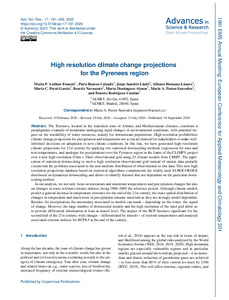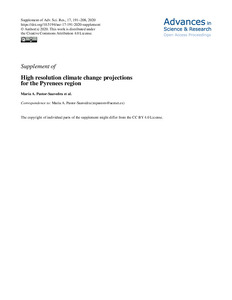Por favor, use este identificador para citar o enlazar este ítem:
http://hdl.handle.net/20.500.11765/12503
High resolution climate change projections for the Pyrenees region
| Título : | High resolution climate change projections for the Pyrenees region |
| Autor : | Amblar, María Pilar



|
| Palabras clave : | Climate change; Projections; Precipitation; Temperature |
| Fecha de publicación : | 2020 |
| Editor: | Copernicus Publications |
| Citación : | Advances in Science and Research. 2020, 17, p. 191-208 |
| Versión del editor: | https://dx.doi.org/10.5194/asr-17-191-2020 |
| Resumen : | The Pyrenees, located in the transition zone of Atlantic and Mediterranean climates, constitute a paradigmatic example of mountains undergoing rapid changes in environmental conditions, with potential impact on the availability of water resources, mainly for downstream populations. High-resolution probabilistic climate change projections for precipitation and temperature are a crucial element for stakeholders to make well-informed decisions on adaptation to new climate conditions. In this line, we have generated high–resolution climate projections for 21st century by applying two statistical downscaling methods (regression for max and min temperatures, and analogue for precipitation) over the Pyrenees region in the frame of the CLIMPY project over a new high-resolution (5 km × 5 km) observational grid using 24 climate models from CMIP5. The application of statistical downscaling to such a high resolution observational grid instead of station data partially circumvent the problems associated to the non-uniform distribution of observational in situ data. This new high resolution projections database based on statistical algorithms complements the widely used EUROCORDEX data based on dynamical downscaling and allows to identify features that are dependent on the particular downscaling method. In our analysis, we not only focus on maximum and minimum temperatures and precipitation changes but also on changes in some relevant extreme indexes, being 1986–2005 the reference period. Although climate models predict a general increase in temperature extremes for the end of the 21st century, the exact spatial distribution of changes in temperature and much more in precipitation remains uncertain as they are strongly model dependent. Besides, for precipitation, the uncertainty associated to models can mask – depending on the zones- the signal of change. However, the large number of downscaled models and the high resolution of the used grid allow us to provide differential information at least at massif level. The impact of the RCP becomes significant for the second half of the 21st century, with changes – differentiated by massifs – of extreme temperatures and analysed associated extreme indexes for RCP8.5 at the end of the century. |
| Descripción : | Número monográfico dedicado al "19th EMS Annual Meeting: European Conference for Applied Meteorology and Climatology 2019". |
| Patrocinador: | The CLIMPY project (EFA081/15) is under the umbrella of the Pyrenees Climate Change Observatory (OPCCCTP), and it has a 65 % funding by the European Regional Development Fund (FEDER) through the Interreg Programme V-A SpainFrance-Andorra (POCTEFA 2014–2020). More information: https: //www.opcc-ctp.org/en/climpy (last access: 26 September 2020). |
| URI : | http://hdl.handle.net/20.500.11765/12503 |
| ISSN : | 1992-0628 1992-0636 |
| Colecciones: | Artículos científicos 2019-2022 |
Ficheros en este ítem:
| Fichero | Descripción | Tamaño | Formato | ||
|---|---|---|---|---|---|
| asr-17-191-2020.pdf | 792,55 kB | Adobe PDF |  Visualizar/Abrir | ||
| asr-17-191-2020-suppl... | 1,54 MB | Adobe PDF |  Visualizar/Abrir |
Los ítems de Arcimis están protegidos por una Licencia Creative Commons, salvo que se indique lo contrario.





